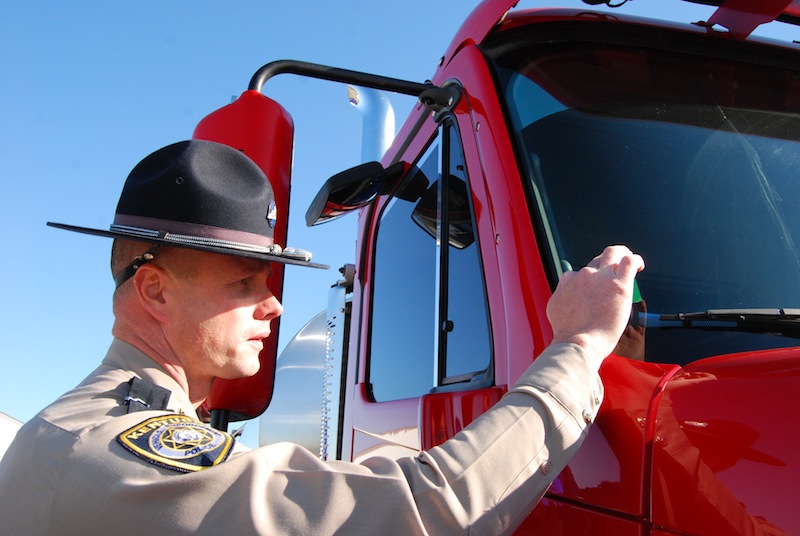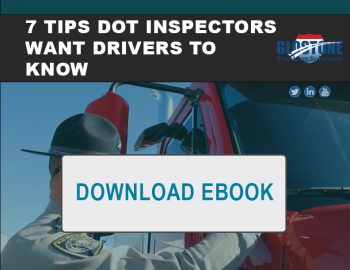
What It Takes To Be A Certified DOT Inspector And Why Fleets and Drivers Should Care
posted in Alerts, Blog, Uncategorized by Brian Gray
What It Takes To Be A Certified DOT Inspector And Why Fleets and Drivers Should Care
According to the FMCSA, approximately 4 million commercial motor vehicle inspections are conducted every year throughout North America to ensure the large trucks and buses driving on our roadways are operating safely. Specially trained inspectors in each state, jurisdiction, territory and province inspect commercial motor vehicles based on inspection procedures and criteria created by CVSA, known as the North American Standard Inspection Program.
Roadside inspectors are highly trained professionals who save lives every day by keeping unsafe commercial motor vehicles and drivers off the roads. The work of a commercial vehicle inspector is not easy, but it is vital in ensuring public safety on North American roadways.
Contact the FMCSA’s National Training Center for more information about DOT Training.
What About Annual Inspections? – §396.17
Every commercial vehicle, including each segment of a combination vehicle requires periodic inspection that must be performed at least once every 12 months. At a minimum, inspections must include all items enumerated in the Minimum Periodic Inspection Standards, Appendix G to Subchapter B of the Federal Motor Carrier Safety Regulations. Motor carriers may perform required annual inspection themselves. The original or a copy of the periodic inspection report must be retained by the motor carrier for 14 months from the report date.
Annual Inspector Qualifications for Motor Carriers
- Inspectors Must Understand Part 393 and Appendix G– Motor carriers must ensure that persons performing annual inspections are qualified. Inspectors must understand the inspection standards of Part 393 and Appendix G and be able to identify defective components, and have knowledge and proficiency in methods, procedures, and tools.
- Brake inspector qualification– The motor carrier is responsible for ensuring that all inspections, maintenance, repairs, and service to brakes of commercial motor vehicles comply with these regulations. The carrier must ensure that the employees responsible for brake inspection, maintenance, service, or repairs meet minimum brake inspector qualifications.
- Qualifying Brake Training or Experience– Qualifying brake training or experience includes successful completion of a State, Canadian province, Federal agency, or union training program, a State-approved training program, training that led to attainment of a State or Canadian Province qualifying certificate to perform assigned brake service or inspection tasks, including passage of CDL air brake test in the case of a brake inspection, or one year of brake-related training, experience, or combination of both.
- Maintaining Evidence of Brake Inspector Qualifications– Motor carriers must maintain evidence of brake inspector qualification at the principal place of business or the location where the inspector works. Evidence must be retained for the period during which the brake inspector is employed in that capacity, and for one year thereafter.
The link to Part 393 is: https://www.ecfr.gov/cgi-bin/retrieveECFR?gp=1&ty=HTML&h=L&mc=true&=PART&n=pt49.5.393
Here is a link to Appendix G: https://www.law.cornell.edu/cfr/text/49/appendix-G_to_subchapter_B_of_chapter_III
This is a link to guidance that the FMCSA has provided to carriers who asked them questions about this topic: https://www.fmcsa.dot.gov/regulations/title49/section/396.17
So what is the point of knowing this as a driver or fleet manager?


With regular training you can:
- Correct unsafe driving that can be the cause of incidents or unnecessary expense
- Create an efficient hiring process
- Have drivers switch to a safer and more fuel efficient driving style
- Improve your company reputation on having conscientious drivers and a process in place to create such conditions that your business is committed to fleet safety
Regular fleet driver training may include:
- Training for new hired drivers, even if they have extensive experience, to be trained according to the policies of your company
- On-going webinar or classroom training on a monthly or quarterly basis
- Training around specific occasions, such as changes within the business or the fleet, if somebody has been involved in an accident, if there are new vehicles coming to the fleet, or after a driver or company has been cited for a violation(s)
Glostone Trucking Solutions is your resource for regular web-based or classroom training for mastering log books, managing CSA scores, refresher on defensive driving, maintenance, pre/post trip vehicle inspection, and more (but not DOT-Certified Inspector Training). Call us about our driver or fleet manager training solutions at 503-607-1088 or check out our Training Solutions







